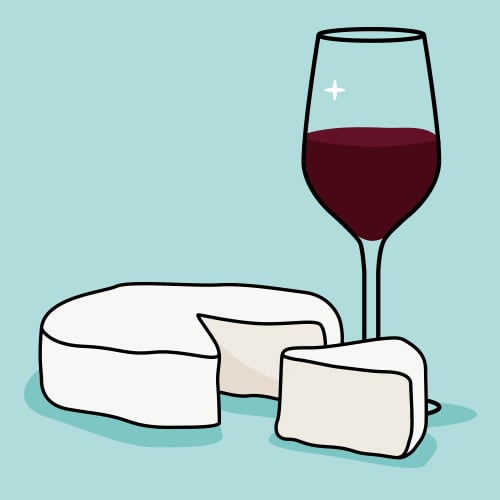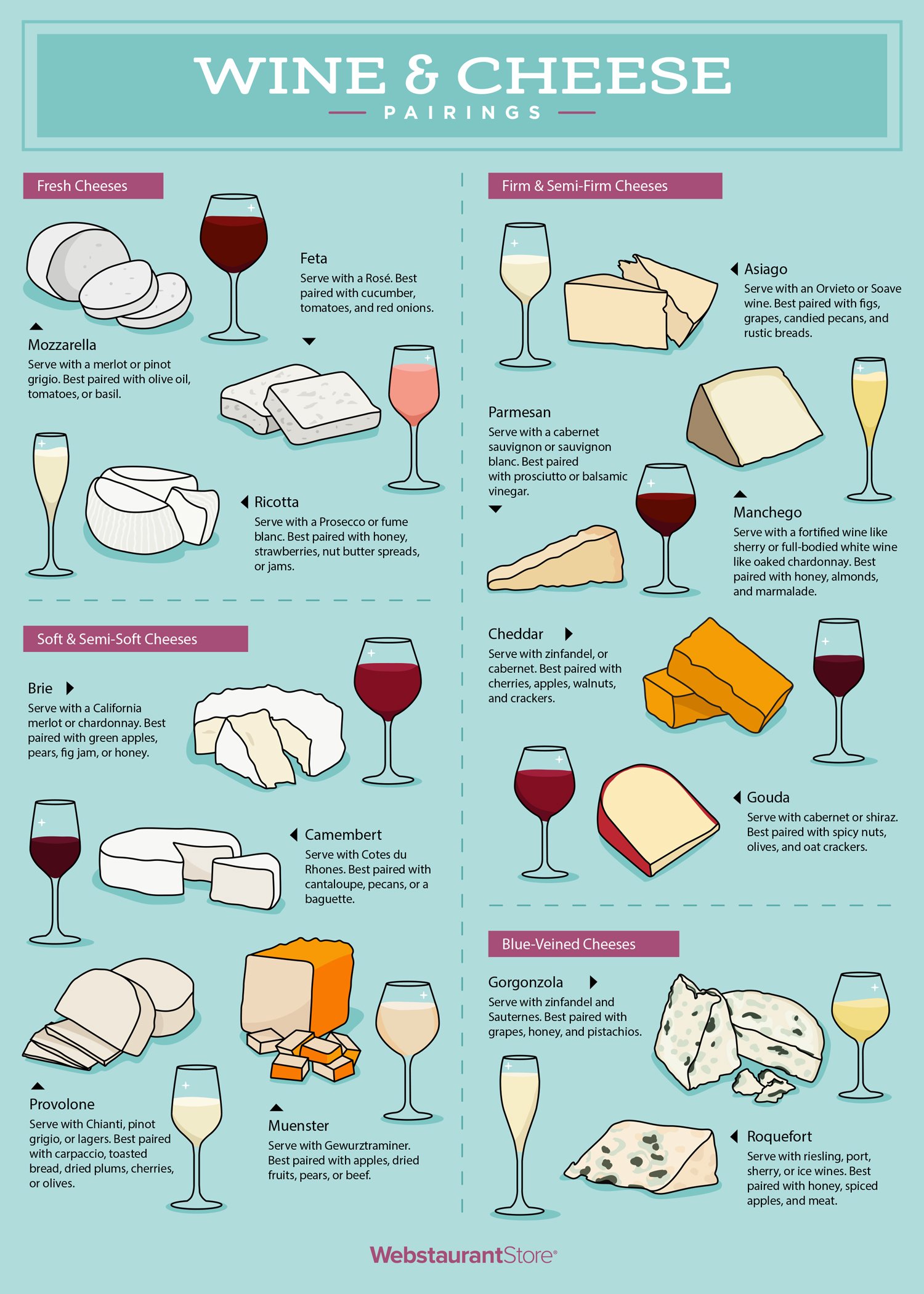
The art of pairing wine and cheese involves finding the perfect balance between flavors, textures, and aromas. Whether you're planning a sophisticated event or looking to embellish your restaurant menu, understanding the principles behind wine and cheese pairings can help you create memorable dining experiences for your customers. We’ll explore the key factors to consider when pairing wine and cheese, as well as provide some expert tips and suggestions to help you make the most of these classic combinations and elevate your wine service.
Cheese and Wine Pairing Guide
Our video provides a helpful visual guide, teaching you how to pair cheese and wine together. Follow along to enhance the flavors of both your wines and your cheeses through artful pairings.
What to Consider When Pairing Wine and Cheese
There are no hard and fast rules when it comes to pairing wine and different types of cheese, but you can bring out the best in both with a complementary combination. Here are some things to consider when curating your menu:
- Intensity of Flavor: A general rule of thumb is to pair delicate cheeses with lighter wines and stronger cheeses with bolder wine varieties. For example, a light and creamy goat cheese would pair well with a crisp and refreshing sauvignon blanc, while a rich and robust blue cheese would be complemented by a full-bodied cabernet sauvignon.
- Texture: Pair creamy cheeses with creamy wines and harder cheeses with more tannic wines. For instance, a creamy Brie would be enhanced by a buttery chardonnay, while a firm Parmesan would be a great match for a structured and tannic Barolo.
- Sweetness: Sweeter table wines or dessert wines can balance the saltiness of some cheeses, while drier wines can contrast with the sweetness of others. For example, a semi-sweet riesling can perfectly balance the saltiness of a tangy Gorgonzola, while a dry Champagne can provide a refreshing contrast to a creamy and sweet Camembert.
- Regional Pairings: Many traditional wine and cheese combinations have developed over time in specific regions. For instance, in France, the terroir of a tangy and earthy Camembert is often enjoyed with a smooth and fruity Beaujolais. Exploring regional pairings can provide a deeper understanding of the relationship between wine and cheese.
Mozzarella

Mozzarella, a widely loved cheese, offers a multitude of wine-pairing options. Whether you prefer red or white wine, mozzarella can go well with both. For a classic combination, pair mozzarella with a light and crisp white wine such as sauvignon blanc or pinot grigio. The smooth and creamy texture of mozzarella also pairs beautifully with red wines like merlot or cabernet sauvignon. Finish off your pairing with ingredients often found in Italian cuisine, such as olive oil and tomato. Whether you're enjoying a Caprese salad or a Margherita pizza, mozzarella can be perfectly accompanied by a glass of your favorite wine.
- Mozzarella Wine Pairing: Sauvignon blanc, pinot grigio, merlot, cabernet sauvignon
- Popular Mozzarella Flavor Pairing: Olive oil, tomato, basil
Feta

A refreshing rose wine is an excellent choice to serve with the flavors of feta cheese. The fruity and floral notes in rose wine accentuate the creamy texture of feta, making it an ideal pairing for a delightful and refreshing combination. Create menu options featuring cucumber, tomatoes, and red onion to play off of the feta’s tangy flavor profile. The crispness of the vegetables highlights the creamy texture of the cheese, while the red onion adds a subtle kick. Whether you're hosting a gathering or simply enjoying a quiet evening, this feta wine pairing is sure to impress.
- Feta Wine Pairing: Rose wine
- Popular Feta Flavor Pairing: Cucumber, tomatoes, red onion
Ricotta

Ricotta, with its creamy and slightly sweet flavor, pairs wonderfully with a variety of wines. For a refreshing and bubbly combination, try pairing ricotta with a prosecco. The crisp and fruity notes of the prosecco complement the delicate richness of the ricotta. Alternatively, a fume blanc can also be an excellent choice, as its bright acidity and citrus flavors can cut through the creaminess of the cheese. Serve your ricotta with a drizzle of honey, fresh strawberries, nut butter spreads, or a dollop of jam. These additions add a touch of sweetness and tang to your charcuterie board that harmonizes beautifully with the ricotta and the chosen wine.
- Ricotta Wine Pairing: Prosecco, fume blanc
- Popular Ricotta Flavor Pairing: Honey, strawberries, nut butter spreads, and jam
Brie

Brie is a soft and creamy cheese originating from France that pairs beautifully with a variety of wines. For a classic and crowd-pleasing combination, opt for a California merlot or chardonnay. The fruity and robust flavors of merlot are an ideal accompaniment with the rich and buttery nature of Brie. Alternatively, the crisp and refreshing notes of chardonnay cut through the creamy texture of Brie, enhancing its delicate flavors. Offer green apples or pears, which provide a crisp and refreshing contrast, with your brie. Fig jam or honey can also add a touch of sweetness and acidity that perfectly balance the flavors of the cheese and wine.
- Brie Wine Pairing: California merlot, chardonnay
- Popular Brie Flavor Pairing: Green apples, pears, fig jam, or honey
Camembert

Camembert has a rich and creamy texture that pairs beautifully with Cotes du Rhone wine. A red wine from the Rhone Valley in France, Cotes du Rhone’s smooth and fruity flavors complement the earthy and nutty notes of the Camembert. The medium body and moderate tannins of Cotes du Rhones make it a versatile choice that can amplify the flavors of the cheese without overpowering it. Camembert goes perfectly with slices of ripe cantaloupe, which adds a refreshing sweetness, and a handful of pecans for a delightful crunch. Don't forget to include a crusty baguette to balance out the richness of the cheese. Whether enjoyed as an appetizer or part of a cheese board, the pairing of Camembert with Cotes du Rhone is sure to please wine and cheese enthusiasts alike.
- Camembert Wine Pairing: Cotes Du Rhones
- Popular Camembert Flavor Pairing: Cantaloupe, pecans, baguette
Provolone

Provolone, a semi-hard Italian cheese, pairs well with wine options like Chianti or pinot grigio. The robust and fruit-forward notes of Chianti create a harmonious balance with the cheese, while the crisp and refreshing qualities of pinot grigio enhance its creamy texture. For those who prefer a beer pairing, lagers serve as a great option. To elevate the tasting experience, consider serving Provolone alongside carpaccio, toasted bread, dried plums, cherries, and different types of olives. These accompaniments provide a delightful contrast that brings out the overall flavor profile.
- Provolone Wine Pairing: Chianti, pinot grigio
- Popular Provolone Flavor Pairing: Carpaccio, toasted bread, dried plums, cherries, olives
Muenster

A soft and creamy cheese originating from the Alsace region of France, muenster is an enticing option for wine pairings. The bold flavors and pungent aroma of muenster cheese pair well with gewurztraminer, a white wine known for its floral and spicy notes. Riesling also has a sweetness that perfectly complements muenster. If you prefer beer, then ales, lagers, and stouts provide a contrasting and refreshing taste to balance out the cheese's intensity. Pair your muenster and wine with apples and pears for a crisp and tart addition that provides a refreshing contrast to the cheese. Dried fruits, such as raisins or figs, add a touch of sweetness that enhances the earthy notes of munster. For those who prefer a heartier pairing, muenster cheese can be enjoyed with beef, as the savory meat brings out the cheese's complex flavors.
- Muenster Wine Pairing: Gewurztraminer
- Popular Muenster Flavor Pairing: Apples, dried fruit, pears, or beef
Asiago

When it comes to wine and cheese pairings, Asiago cheese offers a versatile and delicious option. For a perfect match, consider pairing Asiago with Orvieto or Soave wine. These Italian white wines play well with the nutty and slightly tangy flavors of Asiago. The combination of the wine's citrusy undertones and the cheese's savory profile is sure to delight your diners. Serve the Asiago cheese alongside figs, grapes, candied pecans, and rustic breads. The sweetness of the figs and grapes, along with the crunch of the candied pecans, adds depth to the pairing, while the rustic breads provide a satisfying texture.
- Asiago Wine Pairing: Orvieto, Soave wine
- Popular Asiago Flavor Pairing: Figs, grapes, candied pelicans, and rustic breads
Parmesan

Parmesan, not to be confused with Parmigiano-Reggiano, has a sharp and tangy flavor. Two popular choices for Parmesan wine pairings are cabernet sauvignon and sauvignon blanc. Cabernet sauvignon's bold flavors and firm tannins complement the nuttiness and richness of Parmesan, creating a harmonious combination. On the other hand, the crisp acidity and herbal notes of sauvignon blanc provide a refreshing contrast to the cheese's salty and savory taste. Consider adding prosciutto or drizzling balsamic vinegar over the Parmesan for added complexity and depth of flavor.
- Parmesan Wine Pairing: Cabernet sauvignon, sauvignon blanc
- Popular Parmesan Flavor Pairing: Prosciutto, balsamic vinegar
Manchego

Manchego, a popular Spanish cheese, has a rich and buttery flavor profile that makes it an excellent choice for pairing with a variety of beverages. Opt for a fortified wine like sherry and its popular substitutes, which adds a touch of sweetness to bring out the cheese's complex flavors. Try pairing manchego with a full-bodied white wine like oaked chardonnay to highlight the cheese's nutty undertones. Alternatively, a glass of whiskey can also be a great match for manchego, as the smoky notes of the spirit enhance the cheese's creamy texture. Take the pairing even further by serving manchego with honey, almonds, or marmalade, as these accompaniments provide a delightful contrast of flavors and textures.
- Manchego Wine Pairing: Sherry, oaked chardonnay
- Popular Manchego Flavor Pairing: Honey, almonds, marmalade
Cheddar

With its rich, savory flavor and smooth texture, cheddar cheese is often found on cheese platters. For a bold and robust pairing, consider a full-bodied red wine like zinfandel or cabernet. These wines have enough tannins to balance the sharpness of the cheddar and help to cleanse the palate after each bite while their fruity notes add complexity to the pairing. If you prefer a lighter option, consider pairing cheddar with a porter or amber ale. These beer styles offer a malty sweetness and a touch of bitterness, which work in harmony with the rich and creamy flavors of cheddar. The carbonation of the beer helps to cut through the richness of the cheese, resulting in a refreshing and satisfying combination. To add some additional flavors to the pairing, provide your customers with cherries, apples, walnuts, and crackers for a balance of sweetness, crunch, and acidity.
- Cheddar Wine Pairing: Zinfandel, cabernet
- Popular Cheddar Flavor Pairing: Cherries, apples, walnuts, and crackers
Gouda

When it comes to selecting the perfect wine to serve with Gouda, options like cabernet or shiraz are excellent choices. This semi-hard cheese, originating from the Netherlands, pairs well with bold red wines. The robust tannins in cabernet or shiraz help cut through the richness of the cheese, while the cheese's nutty and caramel notes enhance the fruity and spicy characteristics of the wines. Add accompaniments such as spicy nuts, olives, and oat crackers to your cheese board for the perfect finishing touch. The spiciness of the nuts and the brininess of the olives provide a nice contrast to the smoothness of the cheese, while the oat crackers add a delicate crunch.
- Gouda Wine Pairing: Cabernet, shiraz
- Popular Gouda Flavor Pairing: Spicy nuts, olives, oat crackers
Gorgonzola

Gorgonzola, a rich and creamy blue cheese, is a delightful addition to any wine and cheese pairing. For a red wine pairing, zinfandel is a great choice. The bold and fruity flavors of zinfandel complement the tangy and pungent notes of Gorgonzola. Sauternes, a sweet white wine, also makes a delightful match. The natural sweetness of Sauternes enhances the creamy and salty flavors of Gorgonzola, creating a decadent combination. To elevate the experience, serve Gorgonzola with grapes, honey, and pistachios. The sweetness of the grapes and honey and the nuttiness of the pistachios add contrasting flavors and textures that further enhance the overall pairing.
- Gorgonzola Wine Pairing: Zinfandel, Sauternes
- Popular Gorgonzola Flavor Pairing: Grapes, honey, and pistachios
Roquefort

As a French staple, Roquefort is a blue cheese known for its creamy texture, rich aroma, and distinct tanginess. When creating your wine list, consider pairing Roquefort with riesling, port, sherry, or ice wines. Riesling and ice wine have a balance of sweetness and acidity, which perfectly mellow out the intense and salty flavors of Roquefort. Their crispness helps to cut through the richness of the cheese, while its fruity notes provide a refreshing contrast. Port and sherry have a complexity and robustness that highlight the earthy and nutty undertones of the cheese, resulting in a truly indulgent combination. Prepare a cheese board with honey, spiced apples, or savory meats for a sharable plate that your guests will love.
- Roquefort Wine Pairing: Riesling, port, sherry, ice wines
- Popular Roquefort Flavor Pairing: Honey, spiced apples, and meat
Whether it is a fine dining restaurant, a wine bar, or a catered event, incorporating thoughtful wine and cheese pairings can elevate the culinary experience and set your business apart from the competition. By understanding the principles behind successful pairings and embracing the creativity that comes with them, you can improve customer satisfaction and build a reputation for excellence in the industry. Be sure to serve your wine in the appropriate wine glass to make a lasting impression that will have your customers coming back for more.
Back to Top





